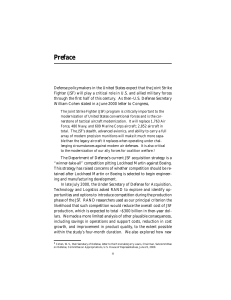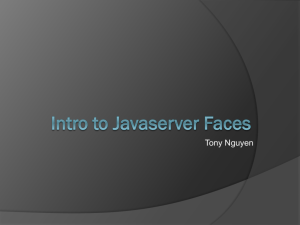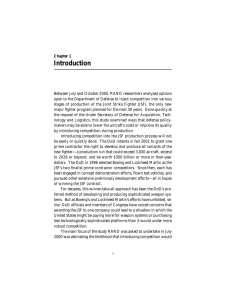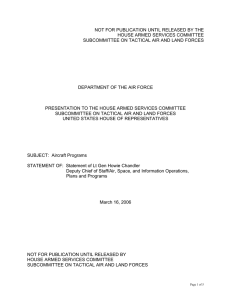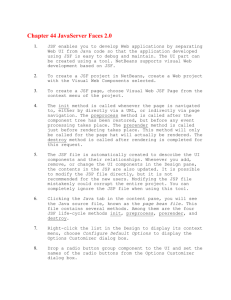Description of the Joint Strike Fighter Program
advertisement
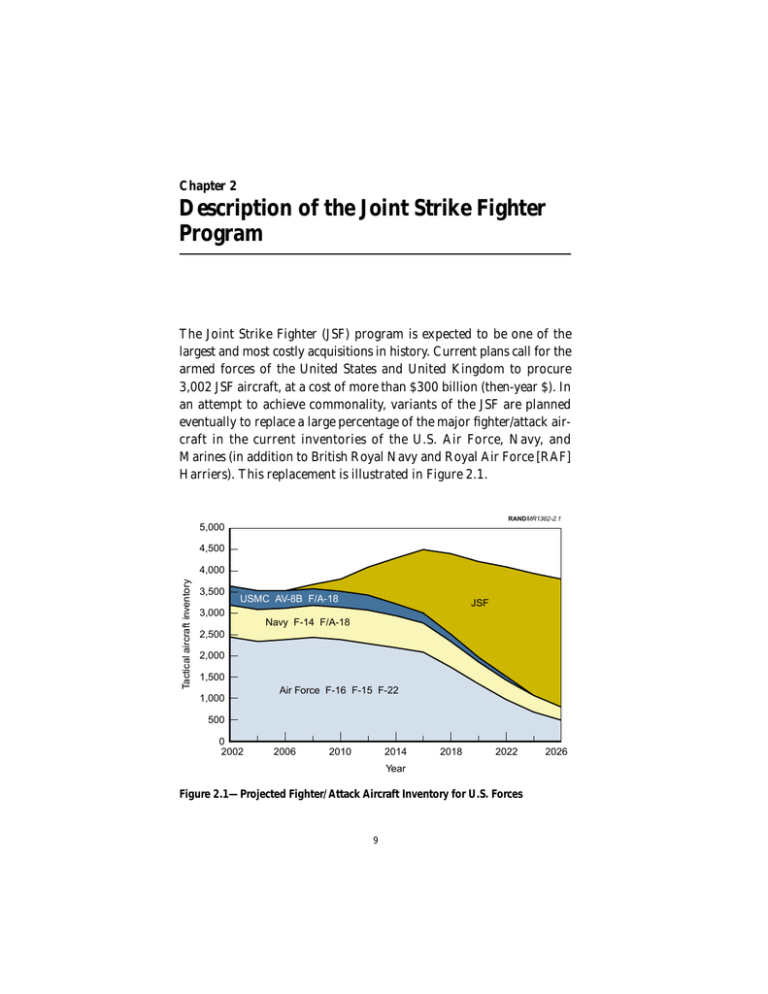
Chapter 2 Description of the Joint Strike Fighter Program The Joint Strike Fighter (JSF) program is expected to be one of the largest and most costly acquisitions in history. Current plans call for the armed forces of the United States and United Kingdom to procure 3,002 JSF aircraft, at a cost of more than $300 billion (then-year $). In an attempt to achieve commonality, variants of the JSF are planned eventually to replace a large percentage of the major fighter/attack aircraft in the current inventories of the U.S. Air Force, Navy, and Marines (in addition to British Royal Navy and Royal Air Force [RAF] Harriers). This replacement is illustrated in Figure 2.1. RANDMR1362-2.1 5,000 4,500 Tactical aircraft inventory 4,000 3,500 USMC AV-8B F/A-18 JSF 3,000 Navy F-14 F/A-18 2,500 2,000 1,500 1,000 Air Force F-16 F-15 F-22 500 0 2002 2006 2010 2014 2018 2022 Year Figure 2.1—Projected Fighter/Attack Aircraft Inventory for U.S. Forces 9 2026 10 ASSESSING COMPETITIVE STRATEGIES FOR THE JOINT STRIKE FIGHTER Following the completion of the current Concept Demonstration Phase (CDP)—during which Boeing and Lockheed Martin, the two competing contractors, will fly concept demonstration aircraft (designated X-32 and X-35, respectively)—DoD plans to select a single prime contractor in a winner-take-all strategy intended to maximize commonality among variants and achieve maximum economies of scale. Therefore, the JSF program also has important implications for the industrial base. This aircraft could end up as the only major fighter aircraft in production in the United States by 2020 or earlier, as shown in Figure 2.2. This compares with the early years of the current decade, which should witness the simultaneous production of at least three fighters (F/A-18E/F, F-22, and variants of the F-16 and/or F-15). Thus, the U.S. government could find itself relying on only one credible source for designing, developing, and manufacturing fighter aircraft by the 2020s. The JSF is particularly important for the U.S. Marine Corps. Currently, the Marine fixed-wing tactical aircraft inventory is made up of RANDMR1362-2.2 JSF (AF) JSF (N) JSF (M) F-22 F/A-18 F-16 F-15 2000 2010 2020 Year Figure 2.2—Projected Production Schedules for U.S. Tactical Aircraft 2030 DESCRIPTION OF THE JOINT STRIKE FIGHTER PROGRAM 11 about 175 Boeing (McDonnell Douglas)/BAE Systems1 AV-8B Harriers, a like number of Boeing (McDonnell Douglas)/Northrop Grumman F/A-18C/Ds, and less than 100 F/A-18A/Bs. All of these aircraft are expected to be retired from the inventory between 2015 and 2021. Plans call for the delivery of the first STOVL JSF variant to the Marines in 2008. By 2011, deliveries are planned to stabilize at their peak level of 36 Marine STOVL variants per year, for an eventual total of 609 aircraft. Thus, by 2021, the STOVL JSF is expected to be the only tactical fighter aircraft in the Marine inventory. The JSF is also crucial for U.S. Air Force modernization requirements. Indeed, the Air Force will be the single-largest customer for the program. The current USAF tactical fighter/attack inventory includes about 2,500 aircraft, made up of nearly 1,400 Lockheed Martin (General Dynamics) F-16s, about 500 Boeing (McDonnell Douglas) F-15s and 200 F-15Es, about 50 Lockheed Martin F-117 stealthy attack aircraft, and about 340 Fairchild Republic A/OA-10 attack aircraft. To replace the F-15 as its premier air superiority fighter, the Air Force plans to buy 339 Lockheed Martin F-22 air superiority fighters. Beginning in 2008, the Air Force expects to begin receiving 1,763 conventional takeoff and landing (CTOL) variants of the JSF to replace the F-16s and A-10s. By the mid-2020s, the JSF will make up about 70 percent of the Air Force tactical fighter inventory. The JSF also plays a key role in the Navy’s aviation modernization plans. The current Navy inventory is made up of fewer than 250 aging Northrop Grumman F-14 fleet air defense fighters, about 150 Boeing (McDonnell Douglas) F/A-18A/B fighter/attack aircraft, and about 350 F/A-18C/D fighter/attack aircraft. Beginning in 1998, the Navy began procuring the first of a planned 548 F/A-18E/Fs to replace the F-14s, which will be phased out of the inventory by 2008, and the F/A-18A/Bs, which will be gone by 2015. To maintain the full forcestructure size requirement as the F/A-18C/Ds begin retiring in large numbers by 2010, the Navy plans to start procurement of the carrier variant (CV) JSF beginning that same year. By the mid-2020s, the CV 1 British Aerospace became BAE Systems on November 30, 1999. 12 ASSESSING COMPETITIVE STRATEGIES FOR THE JOINT STRIKE FIGHTER JSF is planned to make up approximately 60 percent of the Navy tactical fighter force structure. Full procurement of the planned 480 CV JSFs is necessary to meet the Navy tactical fighter force-structure requirement. Finally, STOVL variants of the JSF could replace 150 RAF GR.7 Harriers and Royal Navy Sea Harriers. The JSF and the Eurofighter are expected to become the principal tactical air assets of the UK. Original Acquisition Plan and Program Priorities From the early phases of the JSF program, the intent of acquisition planners was to structure the program differently from past programs in order to reduce overall costs of ownership. DoD designated JSF a flagship program for acquisition reform. Changes to traditional acquisition approaches concentrated on six broad areas: service commonality, the acquisition cycle, the requirements determination process, technical risk reduction, extended design and subsystem competition, and foreign participation. Service Commonality Early in the program it was decided that, to reduce costs through increasing economies of scale and to promote interoperability, variants of the same basic aircraft design would be used to satisfy the requirements for the tactical fighter modernization of three services: Navy, Air Force, and Marine Corps. The competing contractors were encouraged to maximize commonality among their three variants so that they could use the maximum possible number of identical or similar airframe parts, as well as avionics, engine, and other subsystems. The intent was that all three variants could be assembled using a large number of common or similar parts and components. Acquisition Cycle Planners established a Program Office much earlier than is usual, with numerous Integrated Product Teams (IPTs) representing most of the major stakeholders from the acquisition, user, and support communities. In addition, the traditional Concept Exploration and Program Definition and Risk Reduction (PDRR) phases were combined into a DESCRIPTION OF THE JOINT STRIKE FIGHTER PROGRAM 13 single Concept Demonstration Phase (CDP).2 The longer CDP permitted a much lengthier period to conduct more-extensive cost/benefit trade-off analyses, technology assessment, and requirements definition. Requirements Determination The requirements determination process was far more drawn out and iterative than in a traditional DoD acquisition program. From FY95 through FY99, three joint initial requirements documents (JIRDs) were developed through an iterative process that included all stakeholders. Promoted during this period was vigorous application of the acquisition reform concept of Cost As an Independent Variable (CAIV), which raises cost goals to the same level as performance and other system requirements. Indeed, specific Unit Recurring Flyaway (URF) cost threshold targets were established early in the program and became key requirements: $28 million for the CTOL variant, $31–$38 million for the carrier variant, and $30–$35 million for the STOVL variant (costs in FY94 $). To accommodate these targets, the user communities had to make trade-off decisions on the costs and benefits of various performance requirements. The process of developing initial requirements documents led in FY99 to the writing of a draft Operational Requirements Document (ORD) and a subsequent iteration, resulting in a final ORD in mid-FY00. The two U.S. lead prime contractors and their major partners have an unprecedented degree of design and configuration control and responsibility. The ORD states primarily broad performance parameters and URF costs. The contractors have been granted considerable freedom in developing designs, selecting subcontractors, and choosing technologies to meet the performance and cost requirements. For example, each prime contractor has selected different technological approaches to the STOVL lift system, as well as to many other sys2 To be completely accurate, the Joint Advanced Strike Technology (JAST) program, which preceded the JSF program, did have a Concept Exploration phase, which lasted through most of CY94. Rather than being formally viewed as an acquisition program, JAST was viewed as a technology exploration program. The main achievement of the JAST Concept Exploration phase was the conclusion that variants of a single basic design could meet the tactical fighter modernization requirements of all three U.S. services. In addition, the first part of the CDP beginning in November 1994 was originally referred to as the Concept Definition and Design Research Phase. 14 ASSESSING COMPETITIVE STRATEGIES FOR THE JOINT STRIKE FIGHTER tems, such as the electro-optical/infrared systems, the fire control radar, and mission computer architecture. Thus, the contractors are responsible for achieving the required capabilities (performance, reliability, supportability, etc.) within the cost goals established by the government, but the way they do so is left up to them. Risk Reduction Early on, the JSF Program Office identified areas of relatively high technical and programmatic risk, and initiated programs to reduce risk. The main approach selected to manage risk was to fund numerous competitive hardware demonstration programs. One good example is the multifunction integrated radio frequency systems (MIRFS) program. The purpose of the MIRFS program was to encourage companies to develop lighter, much lower cost, active electronically scanned arrays (AESAs) for fire control radars. In an unprecedented risk-reduction effort, the JSF Program Office funded a five-year, $110-million program beginning in February 1996. Contracts were let to the two leading U.S. fire control radar contractors, Hughes Aircraft, which later merged into Raytheon, and Northrop Grumman Electronic Sensors and Systems Sector (ESSS). During CDP, Raytheon was the radar source to Boeing and Northrop Grumman/ESSS was the supplier to Lockheed Martin. Both companies undertook major efforts to develop new technology and manufacturing processes to dramatically reduce the cost and weight of AESAs. The programs included flight demonstrations of prototype arrays incorporating the new technologies. The JSF Program Office funded many other, similar technology risk-reduction programs, including the structures and materials programs, the avionics virtual systems engineering prototyping program, and the joint visual system operational evaluation program. These technology-management and risk-reduction programs differed in several ways from past programs. First, they were more directly linked to specific preferred weapon system concepts being developed by the prime contractors. Second, they often included two competing contractors undertaking the same type of R&D. Third, they were DESCRIPTION OF THE JOINT STRIKE FIGHTER PROGRAM 15 often larger, longer, and more generously funded than similar types of programs in the past. Fourth, they often required development and a full-scale flight demonstration of the actual hardware, rather than laboratory demonstrations. Of course, the most dramatic example of this approach to risk reduction is the requirement of the JSF’s two competing prime contractors to develop and flight-test demonstration aircraft, as discussed below. Competition Throughout the CDP, competition at the prime and subsystem levels was emphasized. During the first year of the CDP,3 three prime contractor teams competed: Boeing, Lockheed Martin, and McDonnell Douglas/Northrop Grumman/British Aerospace.4 In November 1996, DoD selected Boeing and Lockheed Martin to complete the CDP. These two prime contractors would continue to compete until the selection of a single winner-take-all for the Engineering and Manufacturing Development (EMD) phase, now expected to begin in fall 2001. In late 1995, the Alternate Engine Program (AEP) was launched with a $7-million contract awarded to General Electric teamed with Allison (Rolls-Royce). Originally, the Pratt & Whitney F119 engine had been selected for use by all of the prime contractors for their JSF designs. The AEP provided money to complete the full-scale development of the GE F120, so that it would be available as a competitive alternative to the P&W F119 after the initial JSF production phases are completed in the early 2010s. In a like manner, competitive technology programs were funded for many other major subsystems, such as the fire control radar. Each contractor is building and flight testing two demonstrators. Both Boeing’s X-32 and Lockheed’s X-35 first flew in the second half of 2000. These aircraft are intended to demonstrate basic design charac3 Also known as the Concept Definition and Design Research Phase, which lasted from November 1994 to November 1995. 4 After the start of CDP, Northrop Grumman and British Aerospace (British Aerospace became BAE Systems on November 30, 1999) joined the Lockheed Martin team, and Boeing merged with McDonnell Douglas. 16 ASSESSING COMPETITIVE STRATEGIES FOR THE JOINT STRIKE FIGHTER teristics in three areas: commonality and modularity for cost-effective variants for the three services, short takeoff and vertical landing, and low-speed carrier approach and flying capabilities. International Participants Unlike most other major DoD acquisition programs, JSF has included significant foreign participation from the very beginning of the design phase—something no U.S. fighter developed since World War II has included. Foreign government and industry participants have been included for the following reasons: to enhance equipment interoperability with allies, to promote foreign acquisition of the aircraft, to share the financial burdens of development and production, to share U.S. know-how with important foreign allies, and to gain access to unique technologies and capabilities available from key allies. There have been four official levels of foreign government participation during the CDP: • Full Collaborative Partner • Associate Partner • Informed Partner • Foreign Military Sales (FMS) Major Participant. Full Collaborative Partner. The United Kingdom is the foreign participant with the most significant involvement in the program. It is the only Full Collaborative Partner on the program for the CDP portion. The U.S. and UK governments signed a Memorandum of Understanding (MoU) on Royal Navy program participation in 1995. The MoU was modified in 1999 to include the Royal Air Force. The UK is contributing $200 million to the CDP. The UK actively participates in the process of developing JSF requirements documents. The stated objective of the U.S.–UK MoU is to promote harmonization between UK system requirements and the requirements of the U.S. services. UK personnel are included on several IPTs. By the later stages of the CDP, the UK held eight country representative positions at the Program Office, in addition to a National Deputy at the Director level. DESCRIPTION OF THE JOINT STRIKE FIGHTER PROGRAM 17 Associate Partner. Three countries have Associate Partner status during CDP: Denmark, the Netherlands, and Norway. These three countries jointly negotiated agreements that were signed on different dates in 1997. Each country contributed $10 million, which was matched by a U.S. contribution of $30 million, for a total of $60 million. The primary objective of their participation in the CDP is to influence requirements development for the CTOL JSF variant. In line with the terms of the MoUs and Memoranda of Agreement (MoAs), Associate Partners may influence requirements as long as they and the United States perceive the results to be mutually beneficial. Each Associate Partner is represented by one National Deputy and one technical representative during the CDP. Informed Partner. Canada and Italy participate as Informed Partners. The United States signed an MoU with Canada in January 1998, and an MoA with Italy in December of the same year. Informed Partners do not have the authority to influence requirements. Canada participates in design refinements of the CTOL variant, and other associated activities. Italy is involved in a variety of tasks related to the Italian Navy’s interest in the STOVL variant and the Italian Air Force’s interest in the CTOL variant. Canada and Italy are each contributing $10 million toward this joint activity. The United States contributes $50 million to the joint U.S.–Canadian activities. Foreign Military Sales Major Participant. There are three FMS Major Participants in the CDP: Turkey, Singapore, and Israel. All three signed Letters of Offer and Acceptance (LOAs) during 1999. All FMS Major Participants are involved in the generic JSF project, which provides extensive unclassified and nonproprietary information about JSF requirements and designs. Each of the three FMS Major Participants takes part in a variety of different aspects of the CDP. Turkey committed to a contribution of $6.2 million; Singapore and Israel are contributing $3.6 million and $0.75 million, respectively. There is no U.S. financial contribution to these joint FMS Major Participant efforts. A summary of CDP foreign participation is shown in Table 2.1. As of late 2000, negotiations were under way with many of these countries, as well as others, regarding the possibility of developing agreements for participation in EMD. According to press accounts, 18 ASSESSING COMPETITIVE STRATEGIES FOR THE JOINT STRIKE FIGHTER Table 2.1 International Participation in JSF CDP Country Status Agreement Foreign contributions U.S. contributions Date joined United Kingdom Full Partner MoU $200M — Dec 95 Netherlands Associate Partner MoA $10M $10M Apr 97 Norway Associate Partner MoU $10M $10M Apr 97 Denmark Associate Partner MoU $10M $10M Sept 97 Canada Informed Partner MoU $10M $50M Jan 98 Italy Informed Partner MoA $10M — Dec 98 Singapore Major Participant LOA $3.6M — Mar 99 Turkey Major Participant LOA $6.2M — Jun 99 Israel Major Participant LOA $0.75M — Sep 99 RANDMR1362-T2.1 four levels of EMD participation will be available for foreign partners: Levels 1, 2, and 3, and FMS. Level 1 will require approximately a 10percent contribution to EMD costs. Level 2 will require about 5 percent, and Level 3 will require on the order of 1 to 2 percent. The United Kingdom will participate in the evaluation of the CDP flight demonstrations, as well as in the selection of the winning design, and will be the only Level 1 EMD participant. Italy, the Netherlands, and Turkey may be Level 2 participants in EMD. If they join, they will be able to exercise some degree of influence over the EMD program. Level 2 participants will have two to five representatives at the JSF Program Office. Canada, Norway, and Denmark have been mentioned as possible Level 3 participants in EMD. DESCRIPTION OF THE JOINT STRIKE FIGHTER PROGRAM 19 Many other countries have reportedly been invited to take part in EMD as Level 2, Level 3, or FMS participants. As discussed in Chapter Seven, industries from virtually all the participants in the CDP are represented on the two prime contractor teams developing the demonstration vehicles. Current Cost and Schedule The selection of the winner of the JSF program and the beginning of EMD have been delayed about six months, to fall 2001, for a variety of reasons, including DoD’s desire to examine alternative competition strategies for JSF EMD and production, and to further examine the industrial-base implications of a winner-take-all strategy. Also, there is widespread recognition that a new administration will likely want to conduct a major review of U.S. tactical fighter modernization programs before launching JSF full-scale development. The JSF EMD is estimated to cost about $20 billion (FY94 $) and is planned to last a little over 10 years. Fourteen preproduction flighttest aircraft will be built and flown during EMD. The first aircraft to be delivered are planned to be the CTOL variant to the Air Force and the STOVL variant to the Marine Corps in 2008. The first U.S. Navy (CV) and United Kingdom (STOVL variant) aircraft are planned to be delivered in 2010.
